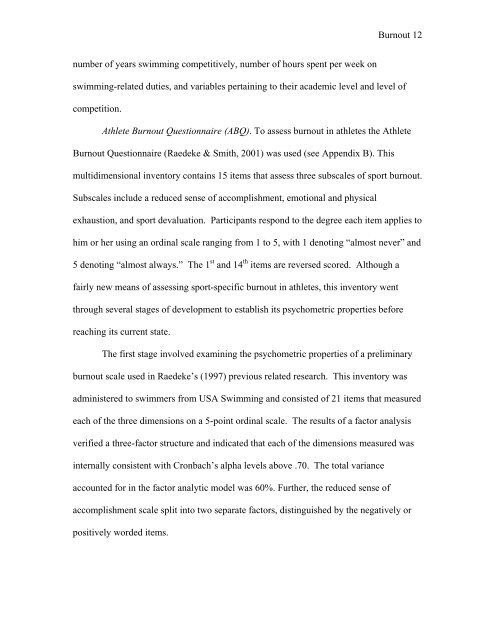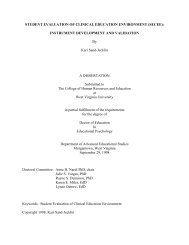Coach and Athlete Burnout - West Virginia University
Coach and Athlete Burnout - West Virginia University
Coach and Athlete Burnout - West Virginia University
Create successful ePaper yourself
Turn your PDF publications into a flip-book with our unique Google optimized e-Paper software.
number of years swimming competitively, number of hours spent per week on<br />
<strong>Burnout</strong> 12<br />
swimming-related duties, <strong>and</strong> variables pertaining to their academic level <strong>and</strong> level of<br />
competition.<br />
<strong>Athlete</strong> <strong>Burnout</strong> Questionnaire (ABQ). To assess burnout in athletes the <strong>Athlete</strong><br />
<strong>Burnout</strong> Questionnaire (Raedeke & Smith, 2001) was used (see Appendix B). This<br />
multidimensional inventory contains 15 items that assess three subscales of sport burnout.<br />
Subscales include a reduced sense of accomplishment, emotional <strong>and</strong> physical<br />
exhaustion, <strong>and</strong> sport devaluation. Participants respond to the degree each item applies to<br />
him or her using an ordinal scale ranging from 1 to 5, with 1 denoting “almost never” <strong>and</strong><br />
5 denoting “almost always.” The 1 st <strong>and</strong> 14 th items are reversed scored. Although a<br />
fairly new means of assessing sport-specific burnout in athletes, this inventory went<br />
through several stages of development to establish its psychometric properties before<br />
reaching its current state.<br />
The first stage involved examining the psychometric properties of a preliminary<br />
burnout scale used in Raedeke’s (1997) previous related research. This inventory was<br />
administered to swimmers from USA Swimming <strong>and</strong> consisted of 21 items that measured<br />
each of the three dimensions on a 5-point ordinal scale. The results of a factor analysis<br />
verified a three-factor structure <strong>and</strong> indicated that each of the dimensions measured was<br />
internally consistent with Cronbach’s alpha levels above .70. The total variance<br />
accounted for in the factor analytic model was 60%. Further, the reduced sense of<br />
accomplishment scale split into two separate factors, distinguished by the negatively or<br />
positively worded items.












